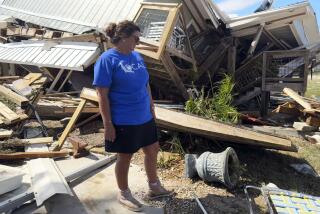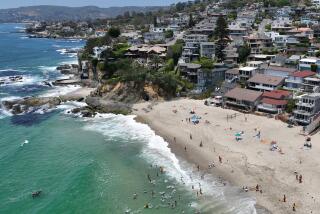New Jersey Shore, ravaged by Sandy, might never be the same
Sandy, the aurora is rising behind us; the pier lights our carnival life forever.
— Bruce Springsteen
POINT PLEASANT, N.J. — There were all of 21 homes on the little cul-de-sac. There wasn’t much space between them and nobody much cared — after all, Riviera Court was surrounded on three sides by water, and everybody’s “yard” was a dock, a boat and a route to the sea, which seemed like such a nice thing just a week ago.
Lori Rebimbas was at home when Hurricane Sandy arrived with sinister clouds, then shrieking wind. It was the water that chased her out, rising to her knees in 10 minutes. As she drove into the darkness, trees tumbled and electrical wires lashed and sparked behind her.
When she made it back, Rebimbas found that the tidal surge from Bay Head Harbor had flooded her neighbors’ homes and crashed through her front door. She stepped inside, onto shattered glass that squished in the carpet. Her bobbed hair fell limp around her face. She lighted a candle in what used to be the living room, and wept.
“I just want a home,” she said.
PHOTOS: Sandy’s devastation on the East Coast
Sandy was 1,000 miles wide and blew through 13 states. Within that immense strike zone, there were places that were shaken, places that were inconvenienced, places that sustained damage and death. Then there were places that may never be the same.
The Jersey Shore had seen its share of bad weather. A winter storm in 1846 wrecked nine ships, and is still known as the Day of Terror. In 1962, a nor’easter washed a Navy destroyer up on the beach in Holgate. But nobody ever saw anything like this, and this time, some aren’t sure they can come back.
In Seaside Heights, a roller coaster fell into the ocean, where it remained Saturday, half submerged, undulating above the waves like the skeleton of a slain sea serpent. A tiny ’57 Chevy was ripped from an old-timey carnival ride and cast far down the beach. Casino Pier, Funtown Pier, Freeman’s Carousel — all gone.
VIDEOS: East Coast hit by deadly storm
“We lost everything. Every single thing,” said Peter Smith, whose family ran several businesses on the century-old boardwalk.
No one has yet tallied up the damage along the coast, partly because the crisis is still unfolding because of power outages, fuel leaks and gas shortages. But Sandy did not discriminate; it took mansions in Mantoloking, fishermen’s cottages in Union Beach, and part of the boardwalk in Atlantic City. The storm, Smith said, grabbed the Shore’s heart, “ripped it out and threw it away.”
The world thought it knew this place. There was a reality TV show that caught fire a few years back, leaning into Italian American stereotypes and documenting the “Guidos” and “Guidettes” who tanned and drank and brawled. But “Jersey Shore” was not the Jersey Shore.
FULL COVERAGE: Super storm Sandy hammers Northeast
The Shore was 127 miles of white-sand nostalgia. For almost 150 years, people went “down the shore,” leaving crowded, hot cities in New Jersey, New York and Pennsylvania for boarding houses, second homes and rentals by the cool ocean.
It was a place of miniature golf and fortune tellers, frozen custard and saltwater taffy. Locals poked fun at the visitors — they called the loud ones “Bennies,” an acronym for Bayonne, Elizabeth, Newark and New York — but they appreciated the business. And many of the towns boomed, at least in summer.
This was where a lot of people first saw the sea, or shared their first kiss. There were a lot of churches, and a lot of bars. It was by no means perfect: The Shore had its seedy side, with economic stagnation, corruption scandals, racial tension. Being “timeless” can also mean stuck in a rut.
But there was something, or some place, for everyone. Soldiers stationed up north started skinny dipping at Gunnison Beach in the 1960s; it’s now the state’s only legal nude beach. In Ocean City, officials banned liquor sales in 1879; that never changed either.
The first Miss America was crowned in Atlantic City in 1921 — she was 16 and won $100 — to keep tourists after Labor Day. Nearly half a century later, activists protested the beauty contest by crowning their own pageant winner — a sheep.
The “Jersey Shore sound” paired Italian accordion with Motown lyricism. By the 1970s the sound had a face. Bruce Springsteen grew up in Freehold, and his second album featured “4th of July, Asbury Park (Sandy),” which is quoted above and was a valentine to the Shore — and a girl named Sandy. That took on a new meaning last week.
There were beaches for new money, for old money, for no money. The working class owned tiny bungalows built on a grid; the gentry lived in gingerbread Victorians that looked like giant doll houses. No matter your station, nobody looked sideways if you told your “daurghter” to wash the sand off in the “warter.”
It wasn’t unusual for generations of a family to head to the same stretch of beach, for children to play in the same neon-lighted arcades that once entertained their grandparents.
Interrupting that tradition, local residents said, would be the greatest loss of all.
Two-thirds of New Jersey’s $38 billion in tourism revenue last year was in the four seaside counties. New Jersey Gov. Chris Christie had made the Shore a pillar of his plans to revive the state’s battered economy.
Christie visited one ravaged beach town after another last week and offered the public a sentimental assessment that sounded like a eulogy. “It’s unfathomable,” he said. “You just can’t recognize the place.”
He vowed that the Shore would be back. Others aren’t so sure.
In the most devastated stretches, recovery hasn’t even begun. Police, worried about gas leaks and other hazards, closed causeways to some barrier islands.
On Friday and Saturday, police went door to door in Seaside Heights to remove residents who had refused to leave. Authorities declared the town — whose population of 3,000 normally swells to 65,000 in summer — unlivable, at least for now.
“Part of your childhood is lost,” said Triantafillos “Tommy” Parlapanides, whose family ran a snack bar that was destroyed. “It’s just gut-wrenching.”
Even some rescuers suffered losses. Bobby Stewart, 59, a volunteer firefighter in Seaside Heights, swam through 6 feet of floodwater to help rescue a couple and their golden retrievers when the storm hit Monday. Once safe, the rescued man began to cry — for putting Stewart at risk.
Stewart ran the Carousel Arcade, a boardwalk haven for pinball, Skeeball and the like. Washed away, all of it, down to the pylons. And the beachfront restaurant that Stewart’s son operated? Smashed in, flooded and full of sand.
“The whole structure of the town — from the sewer to the water to the electric and gas — is all gone,” Stewart said Saturday.
He spent the day at Our Lady of Perpetual Help church, preparing a chicken dinner for firefighters, and plans to help rebuild the town. “I worked for everything I had, and I can do it again.”
Others also looked ahead. Alicia Cook, 26, of Newark, met her husband in Ortley Beach, where sand dunes now blanket roads and some houses vanished altogether. Cook wrote an open letter “to Shore Kids,” which went viral on the Internet.
“This letter goes out to the kids who never cared about the sand in their sheets,” she wrote. “This letter goes out to Exit 82,” the Garden State Parkway exit to Seaside Heights.
“It will be rebuilt, all of it, but it won’t be the same,” she promised. “It will be new and shiny, just waiting for the next generation of locals to carve their initials into it and make it their own.”
More to Read
Sign up for Essential California
The most important California stories and recommendations in your inbox every morning.
You may occasionally receive promotional content from the Los Angeles Times.












